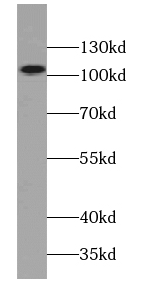Products
TNPO1 antibody
| Size | Price |
|---|---|
| 100µg | Inquiry |
- SPECIFICATIONS
- FIGURES
- CONDITIONS
- FAQS
- Product Name
- TNPO1 antibody
- Catalogue No.
- FNab08940
- Size
- 100μg
- Form
- liquid
- Purification
- Immunogen affinity purified
- Purity
- ≥95% as determined by SDS-PAGE
- Clonality
- polyclonal
- Isotype
- IgG
- Storage
- PBS with 0.02% sodium azide and 50% glycerol pH 7.3, -20℃ for 12 months(Avoid repeated freeze / thaw cycles.)
- Immunogen
- transportin 1
- Alternative Names
- Transportin-1|Importin beta-2|Karyopherin beta-2|M9 region interaction protein (MIP)|TNPO1|KPNB2|MIP1|TRN antibody
- UniProt ID
- Q92973
- Observed MW
- 102 kDa
- Tested Applications
- ELISA, WB
- Recommended dilution
- WB: 1:200-1:1000
 HeLa cells were subjected to SDS PAGE followed by western blot with FNab08940(TNPO1 Antibody) at dilution of 1:300
HeLa cells were subjected to SDS PAGE followed by western blot with FNab08940(TNPO1 Antibody) at dilution of 1:300
- Background
- TNPO1, also named as KPNB2, MIP1, TRN and MIP, belongs to the importin beta family. TNPO1 functions in nuclear protein import as nuclear transport receptor. It serves as receptor for nuclear localization signals(NLS) in cargo substrates. TNPO1 is thought to mediate docking of the importin/substrate complex to the nuclear pore complex(NPC) through binding to nucleoporin and the complex is subsequently translocated through the pore by an energy requiring, Ran-dependent mechanism. At the nucleoplasmic side of the NPC, Ran binds to the importin, the importin/substrate complex dissociates and importin is re-exported from the nucleus to the cytoplasm where GTP hydrolysis releases Ran. The directionality of nuclear import is thought to be conferred by an asymmetric distribution of the GTP-and GDP-bound forms of Ran between the cytoplasm and nucleus. TNPO1 is involved in nuclear import of M9-containing proteins. In vitro, it binds directly to the M9 region of the heterogeneous nuclear ribonucleoproteins(hnRNP), A1 and A2 and mediates their nuclear import. It is involved in hnRNP A1/A2 nuclear export. TNPO1 mediates the nuclear import of ribosomal proteins RPL23A, RPS7 and RPL5. It binds to a beta-like import receptor binding(BIB) domain of RPL23A. In vitro, it mediates nuclear import of H2A, H2B, H3 and H4 histones, and SRP19. In case of HIV-1 infection, binds and mediates the nuclear import of HIV-1 Rev. The antibody is specific to TNPO1.
How many times can antibodies be recycled?
First, usually it's not suggested to recycle antibodies. After use, buffer system of antibodies has changed. The storage condition of recycled antibodies for different customers also varies. Thus, the performance efficiency of recycled antibodies can’t be guaranteed. Besides, FineTest ever conducted the antibody recycling assay. Assay results show recycling times of different antibodies also varies. Usually, higher antibody titer allows more repeated use. Customers can determine based on experimental requirements.
Notes: After incubation, we recycle rest antibodies to centrifuge tube and store at 4℃. High titer antibodies can be stored for a minimum of one week. Reuse about three times.
What are components of FineTest antibody buffer?
Components of FineTest antibody buffer are usually PBS with proclin300 or sodium azide, BSA, 50% glycerol. Common preservative is proclin300 or sodium azide, which is widely applied in the lab and industry.
How about the storage temperature and duration of FineTest antibodies?
Most antibodies are stored at -20℃. Directly-labeled flow cytometry antibodies should be stored at 2 - 8℃. The shelf life is one year. If after sales issues for purchased antibodies appear, return or replacement is available. Usually, antibodies can be still used after the one-year warranty. We can offer technical support services.
Is dilution required for FineTest antibodies? What’s the dilute solution?
Directly-labeled flow cytometry antibodies are ready-to-use without dilution. Other antibodies are usually concentrated. Follow the dilution ratio suggested in the manual. Dilute solution for different experiments also varies. Common antibody dilution buffers are acceptable(e.g. PBST, TBST, antibody blocking buffer).
How to retrieve antibodies for immunohistochemistry?
Common retrieval buffers: Tris-EDTA Buffer(pH 9.0); Citrate Buffer(pH 6.0)
Heat induced antibody retrieval:
Method 1: Water-bath heating: Put the beaker with retrieval buffer and slide in the boiling water bath. Keep the boiling state for 15min. Naturally cool to room temperature;
Method 2: Microwave retrieval: Put the beaker with retrieval buffer and slide in the microwave oven. Heat at high power for 5min, Switch OFF for 3min, Heat at medium power for 5min. Naturally cool to room temperature.
How to choose secondary antibodies?
(1) Secondary antibodies react with primary antibodies. Thus, secondary antibodies should be against host species of primary antibodies. E.g. If the primary antibody is derived from rabbit, the relevant secondary antibody should be against rabbit. E.g. goat anti rabbit or donkey anti rabbit.
(2) Choose secondary antibody conjugates according to the experimental type, e.g. ELISA, WB, IHC etc. Common enzyme conjugated secondary antibodies are labelled by HRP, AP etc. Fluorescin or dye labelled secondary antibodies are applied in immunofluorescence and flow cytometry(e.g. FITC, Cy3).
